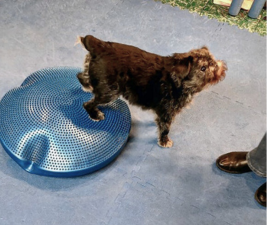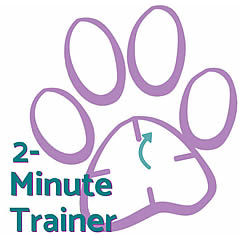Paws and Boots is a training game that doubles as a fitness exercise. Does your dog know that working out is fun?
All dogs know the important stuff. That doesn’t mean all dogs know the same stuff. What I think is important to teach my dog may be nothing at all like the stuff your dog knows. That’s okay. Every dog is trained to their owners’ level of comfort. If it matters to you, you’ll teach your dog.
If you don’t care, that’s fine. One of our current training students doesn’t mind that her dog jumps up on people. There’s absolutely no reason to train this dog not to do it. If you don’t mind, it doesn’t matter.
There is one exception. Every dog owner should care about their dog’s physical well-being, fitness, and body awareness. Like all training games, it’s fast and fun. This one also can make a difference in your dog’s life, extending their comfort and mobility even into their senior years.
Building the foundation
Dogs are a lot like people. When they’re young, strong, and healthy some take advantage of their physical prowess and build healthy habits that last a lifetime. Others are couch potatoes by nature and consider most movement optional and exercise a dirty word.
Whatever you choose for yourself, you should claim a place in the “Healthy Habits” camp for your dog. Muscles and joints are “use it or lose it” features. Making a game of exercise now sets them up for an active and thriving old-dog life.
Play Paws and Boots
Most dogs know they control their front legs and paws. Some use their front paws for much more than just walking. They’ll paw at you for attention, use their front paws to move stuff, even rearrange their bedding with front paws. The vast majority of dogs don’t know they also have back paws. Most have no idea they control their “boots,” too.
To play “Paws and Boots” you need something low, 4 to 6 inches, that your dog can step up on. An inflatable balance disc, a large rubber feed bowl, a short stool, even a cushion will do.
The first step is the easier one. Get your dog to put their front feet on the stool (or whatever you’re using). Like all training games, the dogs learn better if it’s their idea, so be patient. Stare at the stool and reward any interaction with it. If the dog looks at it, reward. The next step may be sniffing it, or pawing it. Reward about three or four times for each level of interaction, then wait for more. Get really enthusiastic with your praise when your dog uses their paws.
When the dog is putting two front feet on the stool, start naming it. Most people say something like “Paws Up!”
Around you go
Once your dog has two feet up on the stool, put pressure on them by moving into their space, even nudging their side with your leg. This is one of the few times we’ll advise holding a treat with the hand further from the dog. With both of you facing the stool, if the dog is on your right side, hold the treat in your left hand, with your arm across your body, close to the dog. As the dog curls their neck toward your treat hand, they’ll move their back legs away from you. Continue all the way around the stool, both directions.
It may take a few sessions to get all the way around. Your dog doesn’t understand what you want yet and may keep dropping down to the floor. Try again, praising every time the dog puts front feet on the stool.
Boots are harder

It’s more difficult to teach dogs their back feet, or “Boots” are under their control. The easiest way to start the Boots portion is to have your dog walk across the stool and stop them with boots up. If they come off the object, just try again, repeatedly walking them over and getting them to stop with boots up. Be sure to repeat the phrase “Boots Up!” when they’re in the correct position so they understand that’s the objective.
When they understand “Boots Up!” it’s time to move them around the stool. For this portion of the game, stand facing your dog and take small steps to either side to encourage them to move their feet. Again, it may take a while for the dog to learn what “Boots Up!” means. Be patient. It’s an exercise for a lifetime, not a deadline.






